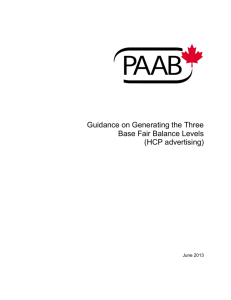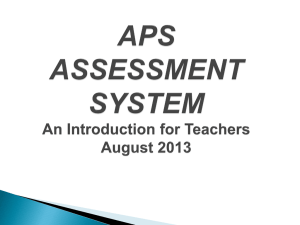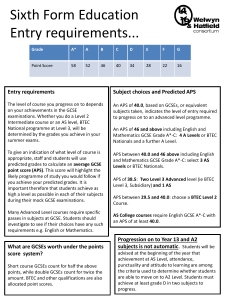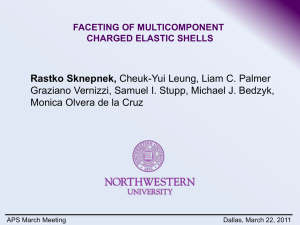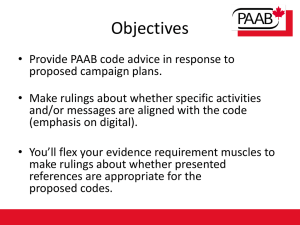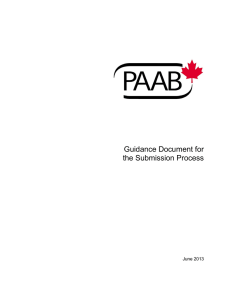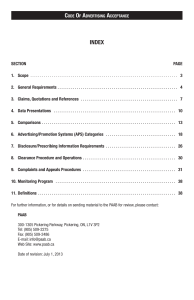Fair Balance (FB) - PAAB Training Portal
advertisement
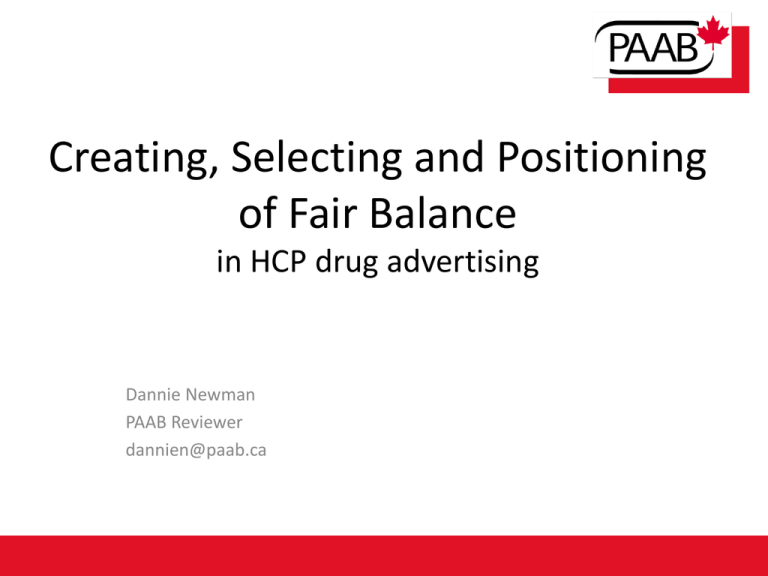
Creating, Selecting and Positioning of Fair Balance in HCP drug advertising Dannie Newman PAAB Reviewer dannien@paab.ca Fair Balance • • • • Fair Balance in the PAAB code Creating the three levels of fair balance Selecting the level of fair balance Positioning fair balance Fair Balance • In alignment with section 9.1 of the Food and Drugs Act, the PAAB Code sections 2.1, 2.4, 3.5 and 7.3 require that risk information be: – Presented within the APS among the claims (s2.1.2) – APS must reflect an attitude of caution (s2.4) – Emphasis only on positive features of a drug while ignoring negative findings is not acceptable (s3.5) – Comprised of content type and quantity which adequately balances the claims – Accurate, Clear, Prominent PAAB code • Rx&D requested that the PI (Product Information) be replaced with a link to the Product Monograph • A committee of industry experts convened on how to meet the above requirements in the context of changes to PAAB code s7.3 • New PAAB code took effect on July 1, 2013 • Guidance documents created to assist in implementing the code changes Guidance Documents Creating the three levels of Fair Balance Creating Fair Balance • There are 3 levels of FB: • See the guidance document “Guidance on Generating the Three Base Fair balance Levels” on the PAAB website Middle Lowest Decreased comprehensiveness Highest Note: when highest level FB is required, PAAB allows option to use middle FB within an APS to direct HCP elsewhere within the same media for highest level FB. Constructing the Highest Level of base Fair Balance Copy Framework: Constructing the Highest Level of base Fair Balance Indications and Clinical Use: • Must appear verbatim at least once in the APS (s2.10.2), among or prior to first set of marketing benefit claims (s2.10.1) • Don’t need to repeat the indication (change section heading) Contraindications: • Include all contraindications except those which are standard across all products (i.e. allergy to product or ingredient/packaging • Separate bullet points Constructing the Highest Level of base Fair Balance Most Serious Warnings & Precautions: • Summary of emphasized W&P from PM (e.g. bolded, boxed, all-caps, underlined, or described as "serious" or equivalent) are described. • Bolded topic followed by description of the warning Secondary Malignancies: The following secondary malignancies have occurred, cutaneous squamous cell carcinoma, new primary melanomas and non-cutaneous malignancy. • Each risk description is separated by a white space Constructing the Highest Level of base Fair Balance Other relevant warnings & precautions: • Only need to include the topic, not a description (point is to identify the W&P, directing the HCP to the TMA for more information) • Separate bullet point for each individual warning • Can be grouped together if done so in TMA or if considered to be adequately descriptive • Be sure to identify if warning is in patients with a preexisting condition, or if it is a side effect of the drug Constructing the Highest Level of base Fair Balance For more information: • Direct reader to complete TMA (link) for information not included in the fair balance • Must include link to the current TMA • Documents are available upon request through a stated phone number Example: For More Information: Please consult the product monograph at www.websitepage.ca for important information relating to adverse reactions, drug interactions, and dosing information which have not been discussed in this piece. The product monograph is also available by calling us at 1-800-XXX-XXXX What can the link lead to? Page housing TMA on the product website Product Information page on the Health Canada Drug Product Database Directly to a PDF of the TMA on the corporate page www.toviaz.ca/PM1583 http://webprod5.hc-sc.gc.ca/dpdbdpp/info.do?code=86588&lang=eng http://www.pfizer.ca/en/our_prod ucts/products/monograph/317 Constructing the Highest Level of base Fair Balance Tips for Highest level fair balance • There is no need to include content relating to indications which are not promoted in the APS • Content may be summarized provided the complete essence is captured. • No need to repeat info presented elsewhere in the APS (section heading should reflect not complete) – Manufacturers may still elect to spread fair balance throughout the APS. • Risk elements which are bolded/boxed in the product monograph are not required to be bolded/boxed in the fair balance presentation: • Some content can be omitted at the manufacturer’s discretion: – See page 11 appendix in guidance document for content that can be removed from FB Appendix from the Supplement: Guidance on Generating the Three Fair Balance Levels The following can be removed from the Fair Balance copy (at the discretion of the Advertiser): • Content which applies to all categories of drugs irrespective of therapeutic area – e.g. contraindications in patients with known allergies to the product or its ingredients – e.g. only use in those who are pregnant/nursing where benefits exceed risk • Instructions which are covered by standards of practice for all drugs – e.g. instruct patients to keep out of reach of children – e.g. only physicians who are knowledgeable with the product or class should prescribe • Copy which has been presented elsewhere in the advertisement/APS • Copy which is promotional Appendix from the Supplement: Guidance on Generating the Three Fair Balance Levels The following can be removed from the Fair Balance copy (at the discretion of the Advertiser): • Copy describing risks which have not been demonstrated to be associated with the product – e.g. Product was shown not be associated with weight gain • Copy about alternative therapeutic options in case of adverse effects on the advertisers product – E.g. Dietary restrictions on Brand X may not extend to other products in the class, another product within the class maybe tried with caution • Explanations why the product is contraindicated in certain populations • Medical definitions and thresholds (except if within the indication statement) Indication Revised Constructing the Middle Level of Fair Balance Copy Framework Indication statement unless stated elsewhere in the APS, e.g. Headline Consult the Product Monograph at www.Xgeva.ca/PM for important information on: • Contraindications in… • Most serious warnings and precautions… • Other relevant warnings and precautions… • Conditions of clinical use, adverse reactions, drug interactions and dosing instructions The product monograph is also available by calling us at 1-800-xxx-xxxx. Middle Level of Fair Balance FAMILAZE acts by inhibiting prostaglandin synthesis Inhibits prostaglandin G/H synthase isoenzymes Also know as COX-1 and COX-2 (p<0.01)* Familaze (rulomine hydrochloride) is indicated for the management of chronic pain associated with osteoarthritis (OA) of the knee Consult the product monograph at www.familaze.ca for important information about: Contraindications in patients with urinary retention, gastric retention, uncontrolled narrow-angle glaucoma, hypersensitivity to tolterodine L-tartrate, soya, peanuts, lactose. Relevant warnings and precautions regarding increased heart rate, interaction with potent CYP3A4 inhibitors, patients at risk of gastric retention, patients at risk of urinary retention, patients with impaired hepatic function, angioedema, patients with myasthenia gravis, patients with controlled narrow-angle glaucoma, patients with impaired renal function, and use of contraception in women of childbearing potential. Conditions of clinical use, adverse reactions, drug interactions, and dosing instructions. The Product Monograph is also available by calling us at 1-800-000-0000 Constructing the Lowest Level of Fair Balance Indication statement unless stated elsewhere in the APS Consult the Product Monograph at www.Xgeva.ca/PM for important information on contraindications, warnings, precautions, adverse reactions, interactions, dosing and conditions of clinical use. The Product Monograph is also available by calling us at 1800-xxx-xxxx. Selecting the level of Fair Balance Selecting Fair Balance Level: • Dependent on the type of claims in the APS No pharmacologic claims Highest Middle Lowest Decreased comprehensiveness Therapeutic claims Pharmacologic claims Selecting Fair Balance Level: Highest level required if APS contains any of the following: Therapeutic claim (e.g. efficacy, safety, tolerability) Compliance/adherence claim Place in therapy claim (e.g. 1st line treatment) Pharmacoeconomic claim Beneficial aspects of risk/burden profile from TMA If not (aside from indication), go to next slide… Selecting Fair Balance Level: Middle level required if APS contains any of the following: Pharmacologic claims other than any of those listed on prior slide (e.g. pharmacokinetics/pharmacodynamic), Presentations describing predefined measured endpoints from clinical trials without disclosing results (e.g. ongoing studies) If not (aside from indication), go to next slide… Selecting Fair Balance Level: Lowest level required if APS contains any of the following: non-pharmacologic claims healthcare product messages other than marketing benefit claims (e.g. cautionary content) messages which do not relate to the healthcare product (e.g. disease information) Selecting Fair Balance Level: • Examples of non-pharmacological claims – – – – – market positioning/experience claims Tablet characteristics/sensory characteristics (i.e. taste/smell) cost comparisons cosmetic/packaging/device characteristics study characteristics without mention of endpoints (e.g. “largest published RCT in diabetes”) – plea to choose/prescribe the product or plea to write “do not substitute” if physician wants to ensure patient receives brand X – claims relating to instructions for use, dosage and or administration information (whether comparative or non-comparative) provided the claim does not allude, in any way, to topics discussed in slide 1 If not, consider whether exempt per s6.6. If unsure submit for an opinion. How the drug interacts with the body in a therapeutic way How the drug interacts with the body in a non-clinical way Claims that don’t relate to an interaction between the product and the body None of the above? Is this piece exempt (s6.6)? Testing your FB knowledge • Which level of FB would you choose? L H L 1) The first and only once-daily antihypertensive therapy 2) A new dose delivery system. Demonstrated safety profile 3) For patients with irritable bowel syndrome NOTE: If after a trial of 2 weeks, patient continues to experience similar side effects and no greater efficacy than previous therapy, continued use should be reassessed. M 4) New Rizaren Tablet for ulcerative colitis Rizaren tablets have microgranules that provide predictable, uniform drug release and delivery. Positioning of Fair Balance Positioning of Fair Balance • Risk information should be where the claims are (meaning in the same parts of the APS). • Risk information should be accorded a degree of prominence which is similar to the claim content. Positioning of Fair Balance • Indication statement – Must appear verbatim in the APS (s2.10.2) – Must appear prior to or among the first set of marketing benefit claims (s2.10.1) • A statement that is designed to promote the sale of a health product • It often promotes a specific product attribute Positioning of Fair Balance General Requirements: – Fair balance should be visually comparable to body copy – Factors to consider in assessing prominence: • • • • • • type size (at least 75% of body copy) spacing duration, pace contrast/shade Readability location Positioning of Fair Balance General Requirements – Fair balance should generally not be presented below product logos (+/- tagline), references, legal mice type and/or footnotes – These elements tend to mark the end of the advertising message portion on a surface Corporate signoff Footnotes Product logo Positioning of Fair Balance Middle to Highest level fair balance • When highest level of fair balance is required you have the option to use middle fair balance direct the reader to the highest level fair balance Linking Middle to Highest Fair Balance: • The highest fair balance must be within the same tool (or directly attached to it) AND in the same media. – pull out the dosing ruler to reveal the highest fair balance. – electronic banner ad directs reader to click a link which takes him/her directly to the highest fair balance. • The middle fair balance must lead directly to highest level fair balance. • Access to the highest fair balance should require little to no effort in dayto-day use of the piece. • Surface must be easy to read Linking Middle to Highest Fair Balance: Middle fair balance must be: • Within the main advertising message • Wording must be adjusted to reflect language directing to the highest level fair balance High Level of Fair Balance 40 Middle Level of Fair Balance 41 … with High Level Fair Balance Option Positioning of Fair Balance • Linear tools vs. non-linear tools • Websites – Safety information should appear on homepage/surface – Safety information tab in menu items which is accessible from all screens (links to highest level of fair balance) Positioning of Fair Balance • Consider fair balance and indication positioning in: – a print detail aid – an email Example: Sample Holder exterior side surface Example: Dosing Slide-out Ruler Summary of Fair Balance • How to create the three levels of fair balance • How to select the level of fair balance required based on the claims in the APS • Where to position the fair balance copy in the APS Any questions??
